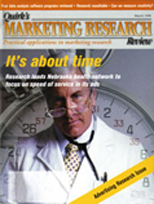The big picture
When you think about winning a huge lottery jackpot, what comes to mind first? Mansions, yachts, chauffeured limousines, and travel around the world, right?
Wrong, if you ask the team at Baltimore-based advertising agency Eisner and Associates who worked closely with the Maryland State Lottery to develop a branding and positioning ad campaign for The Big Game -- a multi-state, mega jackpot lottery game available to Maryland residents.
"Portraying extravagant winnings seems to be a logical path to go down," says David Blum, Eisner’s vice president of strategic planning. "And if we hadn’t thoroughly probed into the mind-set of today’s lottery consumer, we would have ended up developing exactly this type of advertising. The ads would have been expected. They would have been just like other lottery ads, and they would have approached the consumer in the wrong way."
Brand the product
The creation of Maryland State Lottery’s Big Game ads started with internal sales data analyzed by On-Line Product Manager Auburn Bell and Marketing Director Jill Baer, which showed Maryland’s Big Game sales were underperforming compared to other states that offer the product. The challenge was to find out why and help brand the product.
Initial quantitative, qualitative and anecdotal data painted a clear picture of the situation at hand:
- Maryland lottery players were confused. Players routinely said there were too many games being offered and they had a hard time keeping track of them.
- The Big Game was often confused with Lotto, the state’s traditional Pick 6 jackpot game. Some thought The Big Game was just another name for Lotto.
- Players consistently underestimate the size of the Big Game jackpots, which average in the $20 million range. Few could believe the highest ever jackpot was in the $80 million range.
- Most players didn’t realize there were a total of nine ways to win - eight others besides winning the whole jackpot.
- While there was concern that a Maryland resident didn’t always win the big jackpot (players come from seven states), few realized that more than 30,000 Marylanders won something each week playing the game.
As a result, it was clear the product needed a differentiated position from all other Maryland lottery products in general and the Lotto in particular.
Once again, the consumer stepped in to help. "If it’s the most I can win, why don’t you just tell me," the players seemed to demand in focus group settings. Thus, the positioning idea was simple, clear-cut and unique - The Big Game, Maryland’s Biggest Jackpot Game. Moreover, the product was further differentiated from Lotto by branding Lotto as Maryland’s Classic Jackpot game at the same time.
Demonstrate the concept
The creative challenge for Bill Mitchell, Eisner’s creative director, and his team was to find the best way to demonstrate what the concept of the largest jackpot - or winning an awful lot of money - means to the consumer today.
Consumers repeatedly said one notion not only defined what winning lots of money means to them but defined how they view life: I CAN RELAX. In essence, I can do anything I want to do.
The freedom to relax is entirely consistent with much of the Lottery’s and Eisner’s secondary research into today’s consumer. Relaxation means empowerment. Most people like their jobs and their bosses, but they’d like the power not to work if they so choose. Relaxation means precious amounts of time which are rare today. Relaxation means focusing on the family and on the few things that are really important to the individual.
A number of creative executional directions were developed for further consumer review. Some of the directions included:
- Winning means revenge against my boss.
- Winning means I can quit my job.
- Winning means I can spend freely on whatever I want.
- Winning means I have a luxurious lifestyle.
- Winning means I don’t have to sweat the small stuff.
According to Mitchell, "Listening to the market helped us take the seed of an idea and make it even grander. In fact, ‘Sprinkler,’ one of the spots eventually produced, which shows the simple concept of a man leisurely and happily watching his sprinkler all day long because he won the Big Game, was presented in the original focus groups. We knew we were really onto something."
The second spot, "Lockstep," features the same kindly gentleman watching each of his neighbors trudge off to work in the morning in tandem as he again sits on a lawn chair and watches them go by.
"We really made sure we were conveying simplicity and relaxation to their utmost by really paying attention to the details," Blum says. "The man has a modest house in a modest neighborhood. The consumer clearly told us it simply isn’t about money and all the things you can buy these days."
The final pieces
In order to ensure the advertising was going to deliver the appropriate message, mall intercepts were held throughout Maryland before airing the spots. Additionally, other media were employed to deliver the secondary messages, such as "The Big Game is so big, there are nine ways to win and over 30,000 Marylanders win something each week." Initial awareness tracking indicates outstanding proven recall scores for the campaign after just one flight.
